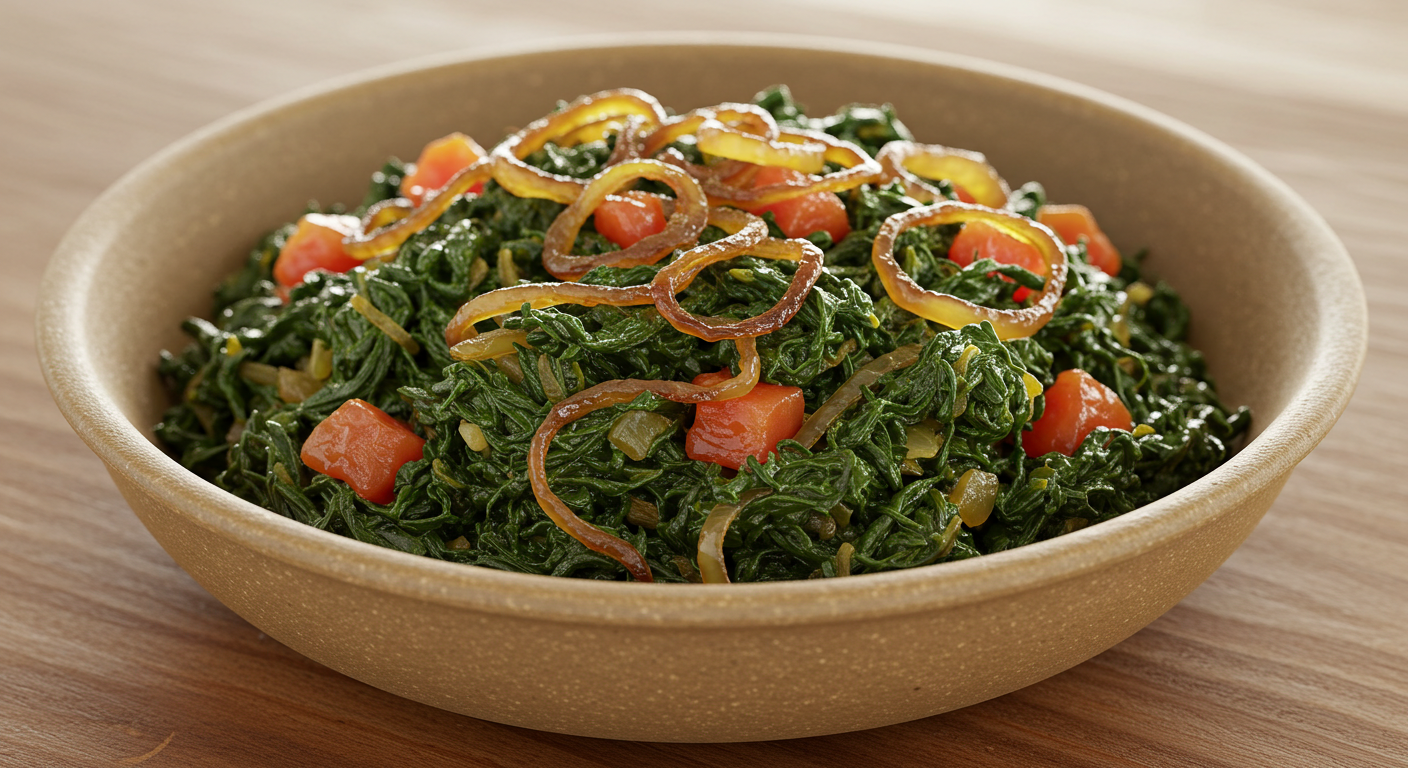In southern Africa, food is far more than sustenance; it is deeply tied to culture, heritage, and the land. One dish that captures this connection is Morogo, also known as African wild spinach. Morogo is not just a single plant but a collective term for several varieties of leafy greens that grow abundantly in the region, including Amaranthus (pigweed), Cleome (spider plant), and cowpea leaves. Cooked with onion and tomato, Morogo is a staple vegetable dish in Botswana and South Africa, cherished for its earthy flavor, nutritional richness, and cultural significance.
Origins and Cultural Context
Morogo has been consumed for centuries across southern Africa, particularly in rural communities where wild greens were often the primary source of vegetables. Before the widespread cultivation of commercial crops, people relied on naturally occurring plants, which were foraged during the rainy season and preserved by drying for later use.
In Botswana, Morogo is considered one of the most traditional and beloved foods, often paired with bogobe (maize porridge) or sorghum meal. Similarly, in South Africa, Morogo is enjoyed in both rural and urban homes, symbolizing the enduring bond between modern diets and indigenous knowledge. Preparing Morogo is not just cooking—it is a way of preserving cultural heritage and honoring the wisdom of elders who knew how to live sustainably with the land.
Nutritional Value
Morogo is sometimes referred to as a “superfood of Africa” because of its exceptional nutritional benefits. Depending on the variety, Morogo is high in:
Iron – important for preventing anemia.
Vitamin A – essential for eye health and immunity.
Calcium – for strong bones and teeth.
Protein – particularly in amaranth leaves.
Dietary fiber – aiding digestion and gut health.
Unlike some cultivated greens, Morogo is hardy and adapts to harsh climates, making it a sustainable crop. For many communities, it remains an accessible and affordable source of vital nutrients.
Preparing Morogo with Onion and Tomato
The most common and beloved way of preparing Morogo is by cooking it with onion and tomato. The process is simple, yet the result is deeply flavorful, showcasing the natural earthiness of the greens.
Ingredients
4 cups fresh Morogo leaves (amaranth, cowpea leaves, or spider plant), washed and chopped
1 medium onion, finely chopped
2 medium tomatoes, diced
2 tablespoons cooking oil (sunflower oil is common)
1 clove garlic, minced (optional)
Salt, to taste
A pinch of chili or curry powder (optional, for added heat)
Instructions
Prepare the Morogo: Rinse the leaves thoroughly to remove any grit. Chop into smaller pieces if necessary.
Sauté the Onion: Heat oil in a pan. Add the onion and cook until soft and golden. Garlic can be added for extra flavor.
Add the Tomatoes: Stir in the tomatoes and cook until they break down into a sauce.
Cook the Morogo: Add the chopped leaves, stir well, and allow them to wilt down. The greens release water, but a splash of water can be added if needed.
Season and Simmer: Add salt and optional spices. Simmer for 10–15 minutes until the greens are tender and the flavors meld.
Serve: Traditionally, Morogo is served hot alongside maize porridge (pap, sadza, or bogobe).
This recipe highlights the simplicity of African cooking—few ingredients, fresh produce, and wholesome flavor.
Variations of Morogo
With Groundnuts (Peanuts): Some households enrich Morogo by adding groundnut paste, giving it a creamy texture and nutty flavor.
With Creamed Spinach Style: In South Africa, some adapt the recipe by adding milk or cream, creating a fusion between traditional Morogo and Western creamed spinach.
Dried Morogo: In rural areas, leaves are sun-dried and later rehydrated for cooking during dry months, ensuring year-round access to this vegetable.
Serving Suggestions
Morogo is typically paired with starchy staples:
With Pap/Bogobe/Sadza: A classic combination where the neutral porridge balances the slightly bitter taste of the greens.
With Rice or Potatoes: A more modern serving option.
As a Side Dish for Meat: It pairs well with grilled chicken, beef stew, or fish, complementing the richness of protein dishes.
Cultural Symbolism
Morogo is not just food—it is memory, survival, and pride. For older generations, it recalls childhood meals in the village, the foraging trips during the rainy season, and the sense of community when families cooked together. For the younger generation, Morogo represents cultural identity and a connection to African traditions, even as diets modernize.
In South Africa, Morogo has also found its way into restaurants that celebrate indigenous cuisine, often served in gourmet style alongside other traditional dishes. This resurgence highlights the growing appreciation of African heritage foods in the modern culinary scene.
Health and Lifestyle Appeal
With today’s global trend toward healthier eating and organic lifestyles, Morogo is gaining recognition beyond Africa. Its high nutrient density and low calorie content make it attractive to health-conscious eaters. Moreover, its sustainable, climate-resilient nature makes it a potential answer to food security challenges in Africa.
Conclusion
Morogo with onion and tomato is more than just a dish—it is a story of resilience, tradition, and nourishment. It reminds us of the deep knowledge embedded in African culinary practices and the value of indigenous foods that have sustained communities for centuries. Whether eaten in a rural Botswana homestead, a South African township, or a modern restaurant, Morogo continues to embody the soul of African cuisine: simple, wholesome, and deeply connected to the land.


